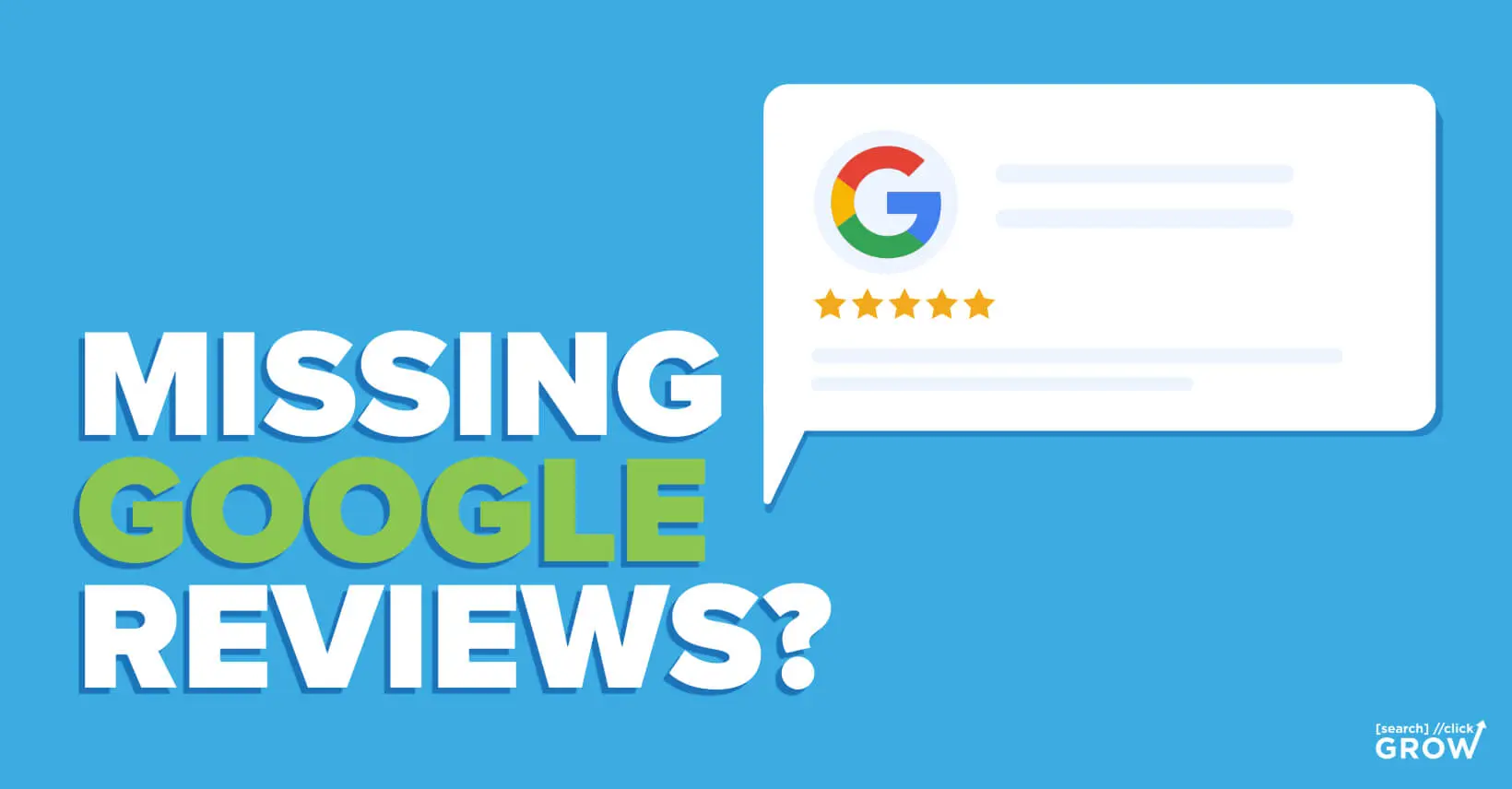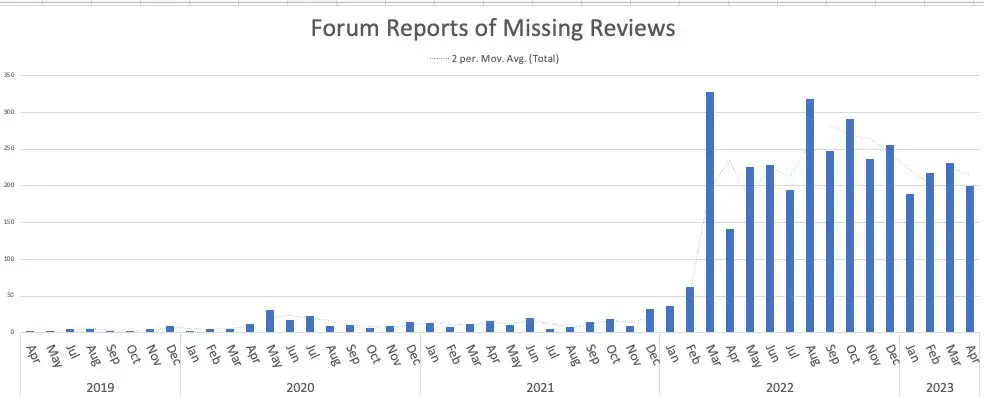
Why Google Reviews Go Missing & How to Fix it (For Contractors)
For local home service business owners, Google Reviews are more than just feedback —they are a cornerstone of local SEO and a driver for attracting new customers.
However, disappearing reviews can be particularly troubling for businesses that rely heavily on their online reputation.
Understanding why Google reviews go missing and what you can do to attempt to fix removed ones can help you manage your digital presence more effectively.
Why Reviews Disappear
Google evaluates the contents of all Google reviews according to its review policy to ensure users provide only honest and unbiased feedback about businesses.
Reviews that are spammy, fake, biased, offensive, or involve conflicts of interest are often removed.
Most Google reviews that don’t show up or suddenly go missing often fall into these categories.

Common Reasons for Missing Reviews
According to Google’s review policies, there are quite a few main reasons that published online reviews can be flagged for policy violation and then removed without warning, or new reviews can be completely prevented from being posted.
Google enforces strict guidelines to ensure that reviews are authentic, relevant, and trustworthy. If a review violates these policies, it may be removed without warning, or new reviews may be blocked from being posted. Here are the most common reasons why Google reviews disappear:
1. Policy Violations
Google’s review policies prohibit certain types of content to maintain the integrity of business ratings. Reviews may be removed if they:
- Contain spam, fake content, or deceptive practices.
- Include hate speech, illegal, abusive, derogatory, or explicit content.
- Share personal information, such as phone numbers, addresses, or other sensitive details.
- Are off-topic and do not mention details about the customer’s actual experience.
2. Suspicious or Fake Reviews
Google’s system actively filters out reviews that seem fraudulent or manipulated, including:
- Anonymous or misleading reviews: If a review is suspected of being intentionally misleading, it may be flagged for removal.
- New accounts or inactive users: Reviews from brand-new Google accounts or accounts with little prior activity may be considered unreliable.
- Accounts with a spam history: If an account has previously posted spammy or low-quality reviews, new reviews from the same account may be removed.
- Mass review spikes: A sudden surge of reviews, especially after a long period of inactivity, may be flagged as suspicious.
- Duplicate or repetitive content: Posting the same review multiple times in a short period can trigger removal.
- Incentivized or promotional reviews: Reviews that appear to be solicited in exchange for compensation, discounts, or gifts can be filtered out.
- Language inconsistencies: If a review is written in a language that doesn’t match the business’s primary language or the reviewer’s previous activity, it may be flagged.
3. Age of Reviews
Google doesn’t always display older reviews, particularly if they:
- Were posted by accounts that are now inactive: If a user’s account has been deleted or suspended, their reviews may disappear.
- Have become outdated or irrelevant: While there’s no official expiration date for reviews, some older ones may lose visibility, especially if newer reviews push them down.
- Were previously flagged but not removed until later: Google may retroactively enforce policy changes, causing older reviews to be deleted even if they initially passed moderation.
4. Technical or Location-Based Issues
Google uses location data and other technical factors to assess the legitimacy of a review. A review may not be published or could be removed if:
- It was posted from an IP address that is too far from or too close to the business location.
- The review was written from a flagged or unverifiable Google account.
- The review appears overly promotional in tone, making it seem like an advertisement rather than a genuine customer experience.
5. Review Gating and Selective Soliciting
Google discourages businesses from manipulating the review process. Reviews may be removed if Google detects:
- Selective requests for reviews: Asking only satisfied customers to leave reviews while discouraging unhappy ones.
- Employee or insider reviews: If a review is left by an employee, former employee, owner, or someone with a conflict of interest, it may be removed.
- Incentivized reviews: If customers are given discounts, free products, or other incentives in exchange for positive reviews, they may be flagged.
6. Business Profile Changes
Google reviews are tied to a business profile, so any major changes can impact their visibility. Reviews may disappear if:
- The business name, address, or ownership has changed.
- The business has been marked as closed or moved to a new location.
- The Google Business Profile was suspended or reinstated after a violation.
7. Other Reasons
In some cases, Google reviews may disappear due to factors outside of policy violations. These include:
- Google Bugs & Glitches: Reviews may temporarily disappear due to system updates, indexing delays, or algorithm changes, often returning after a few days.
- Reviews Under Moderation: Sometimes, reviews don’t appear immediately because they’re under review by Google’s moderation system before being published.
- User-Deleted Reviews: Customers can remove or edit their own reviews at any time, which may cause a previously visible review to disappear.
How Fake Reviews & AI Filtering Impact Google Reviews
Google continuously updates its review moderation process to combat spam and fake reviews. While these efforts help reduce fraudulent activity, legitimate reviews can sometimes be removed by mistake. For contractors and service businesses, this can be frustrating—especially when hard-earned customer feedback disappears.
1. Fake Reviews & Blackmail Attempts
Unfortunately, fake reviews are a growing issue for businesses, including contractors. These can come from disgruntled customers, competitors, or even scammers trying to manipulate a company’s reputation.
- Some businesses have reported customers threatening bad reviews unless they receive discounts or refunds.
- Competitors may leave fake negative reviews to lower your rating and steal potential customers.
- Google tries to remove fraudulent reviews, but real reviews can sometimes get caught in the process.
What Can You Do?
- If you suspect a fake review, report it to Google using the “Flag as inappropriate” option in your Google Business Profile.
- Respond professionally to fake or blackmail reviews—acknowledge them publicly while addressing the situation factually.
- Encourage genuine customers to leave honest feedback to counteract any unfair reviews.
2. Google’s AI & Spam Detection System
Google has increasingly relied on artificial intelligence and automated filters to detect spam, duplicate content, and suspicious activity in reviews. While this improves review quality, it sometimes results in real customer reviews being removed.
- AI filtering may flag reviews that use similar wording or structure, especially if a business receives multiple reviews in a short period.
- Certain keywords (even if used innocently) may trigger Google’s spam detection system.
- Reviews from customers using shared Wi-Fi networks (such as in offices or apartment buildings) could be seen as manipulated and removed.
How to Prevent Reviews from Being Removed by AI
If a review is mistakenly removed, business owners can contact Google support to request a review.
Encourage customers to personalize their reviews rather than using generic phrases like “Great service!”
Ask customers to leave reviews over time rather than in large batches to avoid sudden spikes.
What to Do About Missing Google Reviews
1. Create a Support Ticket
Google openly states that it will not reinstate removed reviews. However, they do have a support form that you can fill out to challenge this.
In some rare cases, they will decide to overturn their decision on some if they are still under moderation. (If you never ask, the answer’s always no!) They also may not respond to you at all, or they may immediately deny your request through email.
You should raise a case with Google within 5 days of the deletion, if possible. Creating a ticket for the issue outside the 5 days reduces the chances of Google acting in your favor.
How to Start a Support Ticket:
- Please make sure you are logged into Google with an account that manages the profile for which you’re looking for support.
- Click this link to start a support ticket here: https://support.google.com/business/gethelp?issue_description=contact+support&sjid=9759675791479720122-NA
- Select the Google profile from the drop-down and click Next.
- Select the Review Missing option and click Next Step
- Skip over their “helpful resources” and click Next Step
- Select the Email option, and a form will drop down. Fill this out to the best of your ability. Optionally, upload an image of the missing review for better chances of recovery. Then click Submit
- NOTE: You will most likely get a canned response email with links to their support. Reply back to that email and request they take a look at your original ticket’s issue and request they review the removed reviews. You may not hear back from them at all – we’ve seen clients suddenly have 10-20+ reviews pop back live.
- Keep track of the case ID from Google. If the situation remains unresolved after 10 days, create a new thread on the Google Business Profile forum with relevant information for a Product Expert’s input.
2. Keep Getting More Reviews
It can be tough not to fixate on losing reviews that you worked hard to get, but the best mindset to have with your review marketing strategy is that some of the reviews you get just aren’t going to stick.
Although Google reviews can be removed for a variety of reasons when you find out a review is lost, it isn’t likely to be recovered. Your time is better spent focusing on getting your next new 5-star review.
Consistency is key here, as you can see from the reasons above. Periods of activity and inactivity look fake to Google and may be taken down. So, stay consistent with those reviews!
3. Diversify Your Review Platforms
Dependency on Google alone can be crippling to your business when there is a problem and can limit your reach. Broaden your review strategy by including platforms like Facebook, Yelp, and the Better Business Bureau (BBB).
These platforms also offer extensive exposure and provide many of the same advantages as Google reviews.
Not only does this diversify, but there’s anecdotal evidence to suggest that good reviews on platforms outside of Google actually help Google rank even more!! So, by getting some reviews on other platforms, you increase your SEO.
4. Regularly Check Your Google Profile Email
Google often notifies business owners via email when a review is removed. Regularly check the email associated with your Google Business Profile for notifications from Google regarding changes to your reviews.
5. Keep Your Profile Active
Your activity level on your Google business profile account also impacts the visibility of your reviews.
If you’re not updating your business information, posting updates, or responding to reviews, Google might consider your business account to be inactive. This could result in your Google reviews disappearing from your Google business profile dashboard.
Understanding Google’s Review Standards
As a business owner, it’s important to understand why reviews from your customers might not be posted or could be removed from Google. Google has specific criteria for customer reviews to ensure they are authentic, informative, and appropriate for all users.
Below is an outline of what Google looks for in reviews. Knowing these criteria can help you comprehend the review process better and guide your customers in providing feedback that is likely to be published and remain on the platform.
This insight is crucial for maintaining a positive and trustworthy online presence.
According to Google’s local guide guidelines, here’s what they recommend for customers when writing and what they look for when moderating:
- Be Informative and Insightful: Describe specific aspects of your experience, what sets the place apart, and share unique details.
- Be Authentic: Detail your personal experience, including both positives and negatives and strive for accuracy.
- Be Respectful: Offer constructive criticism if needed, and avoid profanity.
- Write with Style: Ensure good spelling and grammar, and aim for paragraph-length reviews without excessive capitalization and punctuation.
- Avoid Personal and Professional Information: Do not share personal contact details or URLs, and refrain from reviewing places where you have employment ties.
- Avoid General Commentary: Focus on your firsthand experience rather than social or political issues related to the place.
The Takeaway
Navigating the complex world of Google Reviews requires a strategic approach. Local businesses can boost their online reputation and SEO by understanding the factors leading to review removal and actively engaging in gathering and maintaining a healthy flow of reviews.
Remember, while some google reviews may go missing, the focus should always be on cultivating new, genuine feedback that accurately and attractively reflects your business.
You can also watch a video version of this topic here in our private FB group. We also created an SOP for disappearing google reviews here that you can reference as well.
If you’d like to get help with this, feel free to reach out and book a strategy call with my team.






